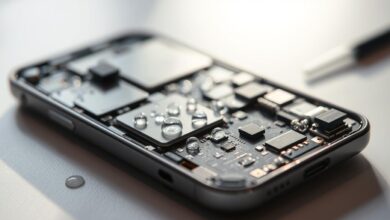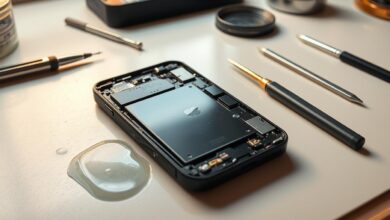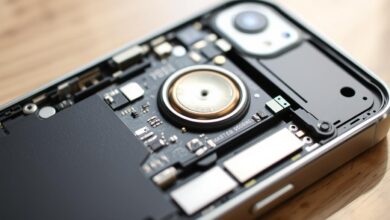how to get water out of speakers on iphone
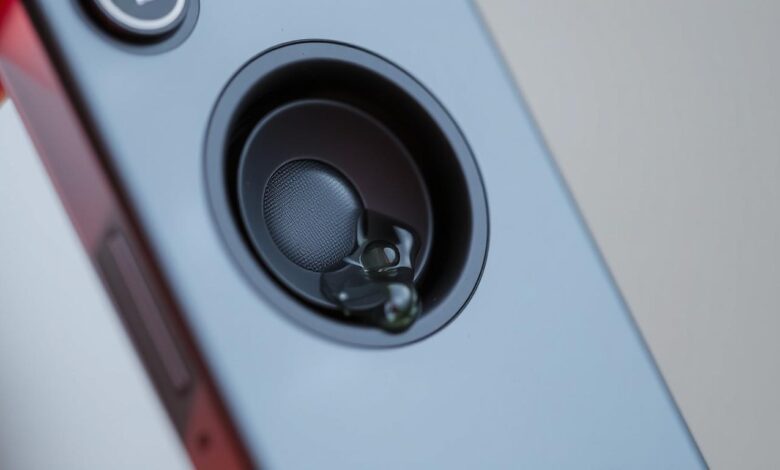
Water damage can ruin your iPhone’s speakers, making sound muffled or distorted. It’s important to know how to remove water from iPhone speakers to fix this issue.
Many people have had their iPhones get wet. Luckily, there are ways to fix it. You can use a Water Eject shortcut to get water out of your iPhone’s speakers.
By following a few easy steps, you might save your iPhone’s speakers from water damage. This article will show you how to remove water from your iPhone speakers.
Key Takeaways
- Understand the risks of water damage to your iPhone’s speakers.
- Learn simple methods to remove water from iPhone speakers.
- Discover the Water Eject shortcut and its benefits.
- Follow step-by-step instructions to salvage your iPhone.
- Prevent future water damage with simple precautions.
Understanding Water Damage in iPhone Speakers
Water damage is a common problem with iPhone speakers. It happens when the speakers get wet by accident. This can make the sound distorted or even stop working.
How Water Affects Speaker Components
Water can really harm the parts inside iPhone speakers. The diaphragm, coil, and magnet can get corroded and damaged. This might make the sound muffled or crackly, or even stop the speaker from working.
To fix water damage in iPhone speaker, knowing how water harms these parts is key.
Common Scenarios Leading to Water Exposure
There are many ways iPhone speakers can get wet. Drops in water, rain, or spills can all cause damage. Using your iPhone in humid places or near water also raises the risk.
Knowing these risks can help you protect your iPhone’s speakers. This way, you can avoid expensive repairs and keep your speakers working well for longer.
iPhone Water Resistance Ratings Explained
Many iPhone users wonder about their device’s water resistance. What does it mean, and how does it differ between models? Knowing about water resistance ratings is key to keeping your iPhone safe from water damage.
The water resistance of an iPhone is based on its IP (Ingress Protection) rating. This rating shows how well a device can handle water and dust.
IP68 Rating: What It Actually Means
The IP68 rating is often mentioned when talking about an iPhone’s water resistance. IP68 means the device is fully protected against dust and can handle being underwater beyond 1 meter. The exact depth and time vary by model, but usually, it means an iPhone can stay up to 4 meters underwater for 30 minutes.
Water Resistance Differences Across iPhone Models
Not all iPhones have the same water resistance. For example, the iPhone 12 and later models have a better water resistance rating than older ones. Here’s a table showing the water resistance ratings of different iPhone models:
| iPhone Model | IP Rating | Depth/Duration |
|---|---|---|
| iPhone 12 | IP68 | Up to 4 meters for 30 minutes |
| iPhone 11 | IP68 | Up to 2 meters for 30 minutes |
| iPhone XR | IP67 | Up to 1 meter for 30 minutes |
Limitations of Water Resistance Features
Even though iPhones have great water resistance, it’s not a complete shield against water damage. Water resistance can wear off over time due to normal use. So, an iPhone can still get damaged by water, even with a good rating.
Signs Your iPhone Speaker Has Water Damage
Water damage to iPhone speakers can show up in different ways. If your iPhone got wet, look for these signs to see if your speaker is damaged. Catching it early can help fix the problem before it gets worse.
Audio Distortion and Muffled Sound
Audio distortion or a muffled sound is a big sign of water damage. Water can block the speaker’s mesh, making sounds unclear. If your music or calls sound off, it might be because of water.
Volume Issues and Crackling Noises
Water damage can also mess with your iPhone’s volume. Sounds might be too quiet or have crackling noises. This happens when water gets to the speaker’s electrical parts. If your volume is high but sounds are weak or distorted, water might be the problem.
Complete Speaker Failure Symptoms
In the worst cases, water damage can make the speaker stop working. If your iPhone’s speaker doesn’t make any sound, it’s a clear sign of damage. You need to act fast to avoid more harm to your device.
| Symptom | Description | Possible Cause |
|---|---|---|
| Audio Distortion | Sound is unclear or muffled | Water clogging speaker mesh |
| Volume Issues | Sound is faint or has crackling noises | Water interfering with electrical components |
| Complete Speaker Failure | No sound is produced | Severe water damage to speaker components |
Immediate Actions to Take When Your iPhone Gets Wet
When your iPhone gets wet, you must act fast to lessen damage. The steps you take right away can greatly affect your device’s recovery. Quick action stops water from getting into the internal parts, reducing corrosion and damage risks.
Power Off Your Device Immediately
First, turn off your iPhone right away. This stops short circuits that could harm it more. Press and hold the sleep/wake button until you see “slide to power off.” Then, slide it to the right. If it’s still working, this stops water from causing electrical issues.
Remove Case and Accessories
Then, take off any case or accessories. This makes drying easier by exposing all surfaces to air. Removing them also stops trapped water from causing more harm. Carefully remove any covers or screen protectors to help dry it.
Proper Drying Position for iPhones
Positioning your iPhone right can help dry it better. Place it with the Lightning port down to let gravity help. You can also tap it gently to remove water. Use a soft, dry cloth to pat the outside and remove moisture. For better drying, use desiccant or silica gel packets nearby but not touching.
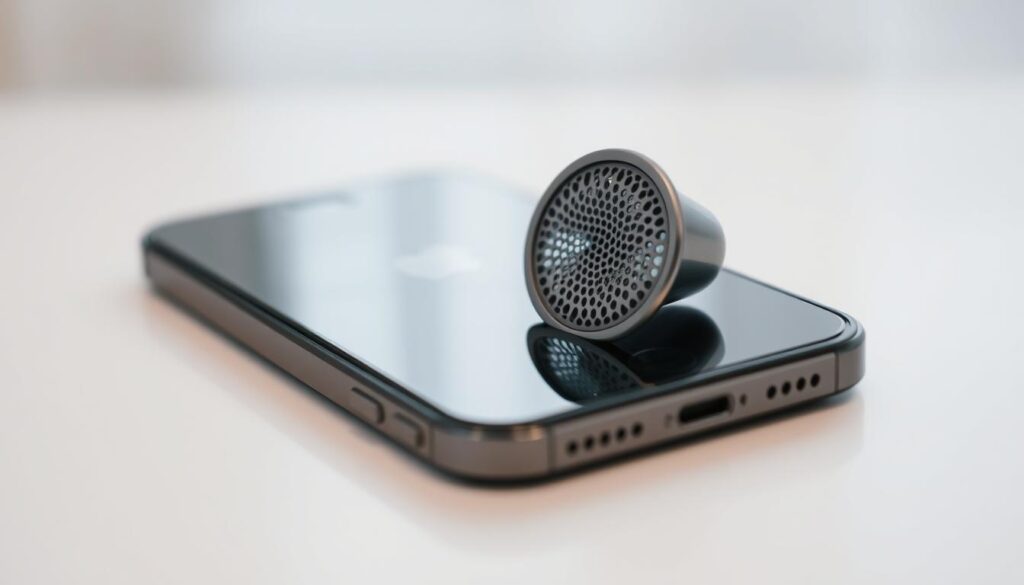
By taking these quick steps, you can greatly improve your iPhone’s chances of recovering from water damage. Acting fast and right can help dry out your iPhone speaker and remove iPhone speaker water, possibly saving it from lasting harm.
How to Get Water Out of Speakers on iPhone Using Sound Waves
Using sound waves is a clever way to remove water from your iPhone speakers. It’s simple and works well. This method uses sound frequencies to push water out of the speaker grills.
The Science Behind Sound Wave Water Ejection
The idea behind sound waves for water ejection is fascinating. Specific sound frequencies create vibrations that push water out. When sound waves hit water, they make the air around it vibrate. These vibrations can dislodge the water, letting it escape from the speaker.
As Apple Support advises, acting fast is key when your iPhone gets wet. Sound waves can help dry out the speakers. You play specific audio frequencies to push water out of the speaker grills.
Using the Water Eject Shortcut
The Water Eject shortcut is a handy tool for sound wave ejection. It’s easy to find and use. Once you have it, you can quickly start the water ejection process.
To use the Water Eject shortcut, follow these steps:
- Download and install the Water Eject shortcut from a reliable source.
- Open the Shortcuts app and find the Water Eject shortcut.
- Tap on the shortcut to start the water ejection process.
- The shortcut will play a sound frequency to eject water from your iPhone speakers.
As noted by
“The Water Eject shortcut is a lifesaver when it comes to removing water from iPhone speakers,” a statement that highlights the utility of this method.
Third-Party Apps for Water Ejection
There are also third-party apps for water ejection using sound waves. These apps work similarly, using sound frequencies to dislodge water.
Some apps let you customize the frequency, so you can try different sounds. It’s important to choose a reputable app and read reviews.
Using Online Water Eject Tools
Online water eject tools are a simple way to get water out of iPhone speakers using sound waves. They are popular because they are easy to use and work well. They don’t need you to touch your phone, which could hurt it.
Web-Based Solutions That Generate Sound Waves
Many websites now have tools that make sound waves to push water out of iPhone speakers. These tools use sound frequencies to make water move out of the speaker grills. The science behind this method involves using sound waves to create vibrations that push water out. It’s a safe way to do this from home.
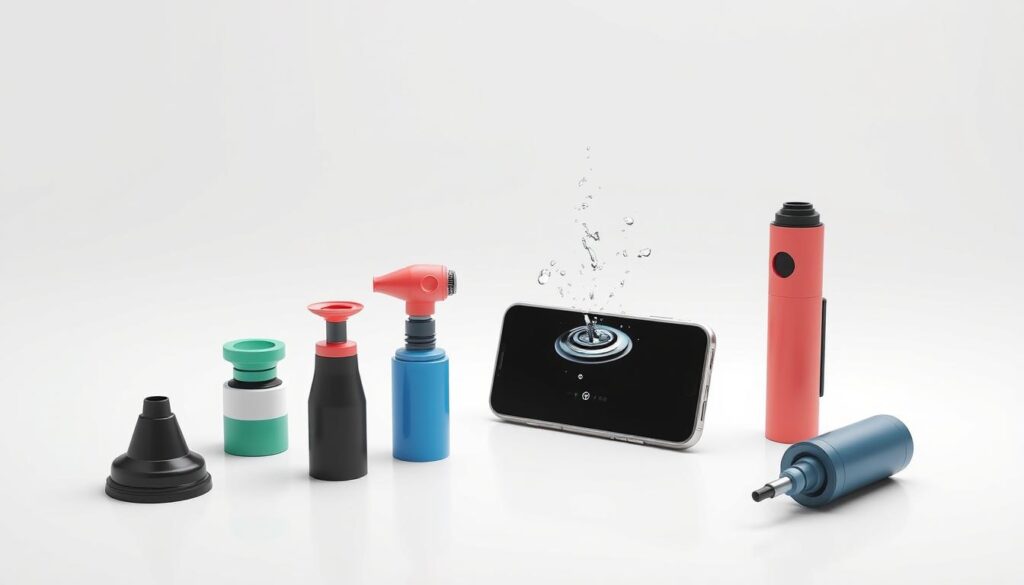
Step-by-Step Guide to Using Online Tools
Using online water eject tools is easy. First, make sure your iPhone is on and the volume is up. Then, go to a trusted website and follow the instructions. You’ll usually click a button to start the sound wave.
It’s important to put your iPhone on a flat surface and make sure the speaker grills are down. This helps water come out. The process might take a few minutes. You’ll see water coming out of the speakers.
After using the tool, check your iPhone speakers for water. If you still see water, you might need to do it again. It’s also a good idea to test your speakers to make sure they work.
Leveraging Your iPhone’s Built-in Features
Using your iPhone’s built-in features can really help when removing water from your speakers. Your iPhone has many tools that can push water out of the speakers. This can help prevent long-term damage.
Using Siri Shortcuts for Water Ejection
Siri Shortcuts are a great tool for removing water. You can make your own shortcuts or use ones that play sounds to push water out. To use Siri Shortcuts, you can either make a new one or pick an existing one that works for water ejection.
| Shortcut Type | Description | Frequency |
|---|---|---|
| Custom Shortcut | Create a shortcut to play a specific sound frequency | Variable |
| Pre-built Shortcut | Use an existing shortcut designed for water ejection | Typically around 165Hz |
Playing Specific Frequencies Through Music Apps
Playing specific sound frequencies through music apps can also help. Some sounds are better at removing water than others. Look for “water ejection sound” or “speaker cleaning sound” on music apps to find good tracks.
Some music apps have special features or playlists for water ejection. Using these can help make sure your iPhone’s speakers are water-free.
The Rice Method: Does It Really Work?
Using rice to dry iPhone speakers is a topic of debate. Many people say it works, claiming it absorbs moisture. But, not everyone agrees, and there are things to think about.
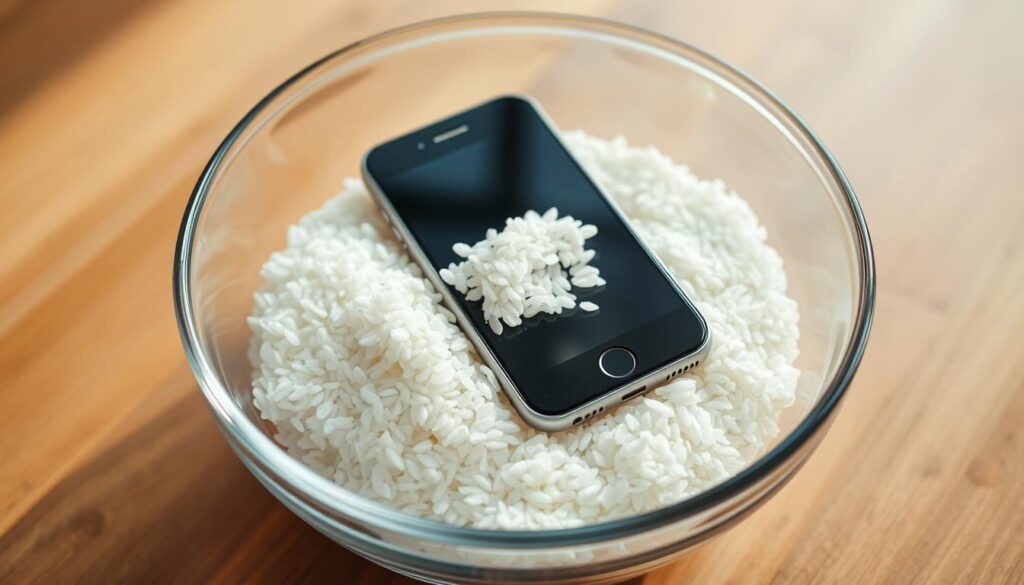
Proper Technique for Using Rice
To dry your iPhone with rice, follow these steps. First, turn off your iPhone to avoid short circuits. Then, take off any accessories or cases that might get in the way.
Next, put your iPhone in a container filled with uncooked rice. Make sure it’s fully covered. It’s recommended to leave it there for at least 48 hours before trying to turn it on again.
Some people have had success with this method. They say the rice absorbs moisture. But, it’s not a sure thing. How well it works depends on the water damage.
Limitations and Potential Risks
The rice method might seem safe, but there are risks. Rice dust can get into your iPhone’s ports and cause more harm. Also, if the water damage is bad, rice might not dry everything out.
“The rice method is a hit-or-miss solution. It might help in some cases, but it’s not a reliable fix for water-damaged iPhones.”
A comparison of drying methods is shown in the table below:
| Drying Method | Effectiveness | Risks |
|---|---|---|
| Rice Method | Variable | Rice dust damage |
| Silica Gel | High | Low |
| Compressed Air | Moderate | Potential for pushing debris further in |
In conclusion, the rice method might help dry out your iPhone speaker. But, it’s important to know its limits and risks. For serious water damage, you might need to try other methods or get professional help.
Silica Gel and Desiccants: A Better Alternative
Silica gel and desiccants are better than old methods for drying wet iPhone speakers. They work better than rice, which has its own problems. These products are made to soak up moisture, perfect for drying out gadgets.
Effective Use of Silica Gel Packets
To dry your iPhone with silica gel packets, put it in a container with the packets. Make sure the iPhone is fully covered. The silica gel will pull out the moisture, including from the speakers. You need enough packets to soak up all the moisture.
Tips for Using Silica Gel Packets:
- Choose a big container for your iPhone and silica gel packets.
- Close the container to keep moisture out.
- Keep your iPhone in there for 24 to 48 hours.
Finding and Using Desiccants
Desiccants come in many forms, like silica gel packets, desiccant bags, and even cat litter. Make sure the desiccant you pick is good for drying electronics.
| Desiccant Type | Effectiveness | Availability |
|---|---|---|
| Silica Gel Packets | High | Electronics Stores, Online |
| Desiccant Bags | Medium to High | Hardware Stores, Online |
| Cat Litter (Desiccant Type) | Medium | Pet Stores, Supermarkets |
How long you use desiccants depends on the type. But, 24 to 48 hours is usually enough. Check your iPhone often to see if it’s dry and working right.
Using Compressed Air to Remove Water
Removing water from iPhone speakers with compressed air works well if done right. This method uses compressed air to push water out of the speaker grills and inside parts.
Safe Techniques for Using Compressed Air
To safely use compressed air, hold your iPhone up and spray short bursts into the speaker grills. Make sure not to spray too close or too hard, as it might harm the inside parts. For more tips on drying your iPhone safely, check out methods for removing water from charging ports.
Potential Risks and Precautions
Compressed air can be useful, but there are dangers. Too much pressure or spraying too close can push water deeper into the iPhone or damage the speakers. Always use compressed air cans made for electronics cleaning. They are less likely to have moisture or harmful stuff.
Testing Speaker Functionality After Water Removal
After removing water from your iPhone speakers, it’s important to test them. This step makes sure you got rid of the water and your speakers are working right.
Audio Test Methods to Verify Success
To check if your iPhone speaker works after water removal, try a few audio tests. First, play some music to see if it sounds clear. You can also use a video with clear audio or a voice memo for better sound quality.
Another good way is to use an audio frequency test from online platforms or apps. These tests show if your speaker can play sound at different frequencies without problems.
| Test Method | Description | Expected Outcome |
|---|---|---|
| Playing Music | Play a song or music to check for distortion | Clear, undistorted sound |
| Audio Frequency Test | Use online tools or apps to test different frequencies | Sound produced across all frequencies |
| Voice Memo | Record and play back a voice memo | Clear, crisp voice without distortion |
Troubleshooting Persistent Audio Issues
If your iPhone speaker still doesn’t work right after testing, don’t worry. First, clean your speaker grills to remove dust or dirt. Sometimes, these can mess with sound quality.
If cleaning doesn’t fix it, you might need to try again or use a different method. In some cases, professional help may be required if the problem keeps happening.
What Not to Do When Removing Water from iPhone Speakers
Not all ways to remove water from your iPhone speakers are safe. Some methods can actually harm your device more. It’s important to know the common mistakes that can make things worse.
Dangerous Methods to Avoid
Some methods, though meant to help, can actually push water deeper into your iPhone. Using a hairdryer or any heat source is a big no-no. The fast heat can damage your iPhone’s electronics.
Also, don’t put things like cotton swabs or paper towels in the speaker grills. They can push debris in or scratch the parts.
Another bad idea is to soak your iPhone in cleaning solutions or alcohol. These liquids can corrode your iPhone’s parts or harm the speaker diaphragms. Don’t shake your iPhone hard or use too much force. This can dislodge parts or damage the speakers.
Common Mistakes That Cause Further Damage
Avoiding common mistakes is crucial to fix your iPhone speakers. Not turning off your iPhone right away can cause short circuits. Also, don’t leave the case and accessories on, as they can trap water.
Not drying your iPhone well or waiting too long can lead to corrosion or permanent damage. Knowing these dangers helps you avoid them and might fix your iPhone’s speakers.
When to Seek Professional Help
If your iPhone’s speaker still doesn’t work after water damage, it’s time to get help from a pro. DIY fixes can help, but they might not fix everything.
Knowing when to ask for help is key. If your iPhone’s speaker keeps having problems, like bad sound or not working at all, it’s a sign you need a pro.
Signs That DIY Methods Aren’t Working
Trying DIY fixes and still having issues? It might mean the problem is bigger than you can fix yourself. Watch for these signs:
- Persistent audio distortion or muffled sound
- Complete speaker failure
- Intermittent audio issues
These signs point to deeper damage inside your iPhone. It needs a pro to fix it.
| Symptom | Possible Cause | Recommended Action |
|---|---|---|
| Persistent Audio Distortion | Water damage to speaker components | Seek professional repair |
| Complete Speaker Failure | Extensive water damage or corrosion | Consult a professional for repair or replacement |
Finding Reputable Repair Services
Finding a good repair service is important. Look for ones that:
- Have experience with iPhone repairs
- Use genuine or high-quality replacement parts
- Offer warranties on their repairs
Choosing a trusted repair service means your iPhone will work like new again.
Conclusion
Removing water from iPhone speakers needs quick action and the right methods. We’ve looked at many ways to help you fix your device. This includes understanding water damage, iPhone water resistance, using sound waves, online tools, and desiccants.
When your iPhone gets wet, acting fast is key. Turn it off, remove accessories, and dry it correctly. Using sound waves through the Water Eject shortcut or apps can also help.
In summary, combining quick actions with the right methods can fix your iPhone’s speakers. Being careful and using these techniques can help remove water and get your iPhone working again.
FAQ
How do I remove water from my iPhone speaker?
To remove water from your iPhone speaker, try sound waves, online tools, or desiccants like silica gel. Sound waves are a simple, non-invasive method to start with.
Can I use the rice method to dry out my iPhone speaker?
The rice method is not the best for drying iPhone speakers. It can leave dust and starch, causing more harm. Instead, use silica gel packets or desiccants.
How do I know if my iPhone speaker has water damage?
Signs of water damage include audio distortion, muffled sound, and volume issues. If you notice these, your speaker might be damaged.
Can I use compressed air to remove water from my iPhone speaker?
Compressed air can help, but use it carefully. Short, gentle bursts are best. Avoid spraying too close to the speaker.
What should I do immediately after my iPhone gets wet?
Turn off your iPhone, remove cases, and dry the outside with a soft cloth. Place it in a dry area, with the speaker down to drain water.
How can I prevent water damage to my iPhone speaker?
Keep your iPhone away from water and moisture. Use a waterproof case and be careful near water. Act fast if your iPhone gets wet.
Can I fix my iPhone speaker myself, or do I need professional help?
Try DIY methods first. If they don’t work, seek professional help. Look for reputable repair services and avoid scams.
Are there any third-party apps that can help eject water from my iPhone speaker?
Yes, apps that generate sound waves can help. They’re an alternative to online tools or Siri shortcuts.
How do I test my iPhone speaker after water removal?
Play music or a video with clear audio to test your speaker. Listen for any issues. If problems persist, try troubleshooting or seek help.
